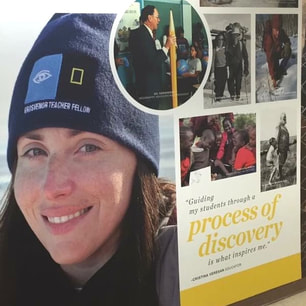Bay Area Wonders, Volume 3!
|
My 5th graders once again researched native species and explored their personal connections with them in illustrated natural history essays inspired by Aimee Nezhukumatathil's sublime World of Wonders.
All the student essays were anthologized in a beautifully bound book called Bay Area Wonders, volume 3 that's a real celebration of local biodiversity! |
Illustrated Climate Graphs
For this project, 5th grade students analyzed climate data sets. Then, they incorporated an actual graph line into an original watercolor depicting a specific impact of climate change they researched. The technique was inspired by the data art of science communicator/artist Jill Pelto. Enjoy the beautiful examples below— can you spot the line graphs?
I recently wrote a blog for NOAA called "Sci-Art Lesson Share: Illustrated Graphs" if you want to read some thoughts on the intersection of science and art and check out some more lovely student work.
Wonder Essay Curriculum Published
|
This expanded paperback edition of the NYT-bestselling World of Wonders by Aimee Nezhukumatathil (and illustrated by Fumi Nakamura) was just released by Milkweed Editions. The book is a beautiful blend of memoir and nature writing, and it inspired my Bay Area Wonders project detailed in this blog post.
I’m overjoyed that my collaborator Cliff Burke and I are credited in its Teaching Guide for our accompanying discussion prompts and our full Wonder Essay Curriculum. Teachers, to access the secondary science & writing curriculum, please visit Milkweed Editions' website: milkweed.org/world-of-wonders-educator-resources |
MiddleWeb Article on Women in STEM
|
Read some of my thoughts on a resource to help educators promote diversity in STEM fields and shift cultural perceptions of what science is and who can do it. The blog was inspired by Erin Twamley and Josh Sneiderman's latest book Everyday Superheroes: Women in STEM Careers. The book features 26 prominent women of color in STEM careers from A-Z (Astronomy to Zoology). Young readers will be amazed by the profiles of the superheroes and they will be challenged to develop their own STEM superpowers through embedded activities. Click here to read the blog, and click here to order a copy of Everyday Superheroes.
|
Science Scope Article on Plankton
|
I have a featured article in Science Scope (January 2019, Oceans Issue) called "The Microscopic World of Plankton." Science Scope is the middle school journal of the National Science Teaching Association (NSTA). The article describes a series of activities for students to investigate plankton and better understand plankton's role in aquatic ecosystems. Students can engineer a plankton net out of household materials, observe plankton specimens with a microscope, and construct a visual model of an aquatic food web!
Click here to read the article. Click here for a Plankton Primer info sheet. Click here for the Plankton Activity Cards. |
|
Cristina Veresan
Science Educator |
Proudly powered by Weebly
|












